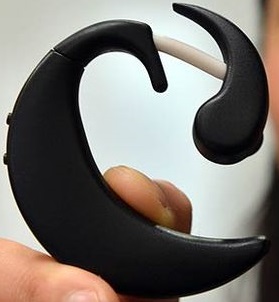Researchers in Japan are now testing a very small computer that can fit into the human ear.
As wearable technology explodes, particularly in the form of smartwatches, researchers in Japan are taking things a step further and are developing a tiny personal computer that a user can wear in his or her ear.
Users would control this device with a click of the tongue or a blink of the eye.
This wearable technology weighs only 17 grams and is completely wireless. It uses Bluetooth to connect with other devices and is equipped with a battery, speaker, microphone, compass, GPS, barometer, and gyro-sensor. Computing in the form of wearables is believed to be the latest thing in tech, but this latest development is easily among the smallest and most hands-free that has made its way to the headlines.
Other forms of wearable technology are notably larger, such as Google Glass, and Samsung Galaxy Gear 2.
This particular wearable technology for the ear is being called the “Earclip-type Wearable PC”, for the moment. It has microchip and data storage, which gives users the ability to load software. This, according to Kazuhiro Taniguchi, an engineer at the Hiroshima City University. The designs for the device are based on the traditional Japanese flower arrangements known as “ikebana”.
Taniguchi explained that the team of mobile developers created the device so that people would be able to think of wearing it in the same way that they would think about wearing earrings. The prototype for the gadget was demonstrated in black and had an overall comparable look to the sports style earbuds that wrap around the ear, or a single ear telephone headset.
The researchers are working to have this wearable technology ready by the holiday shopping season in 2015. At that time, users will be able to connect the device to their mobile devices such as an iPod or other gadgets that allow the user to navigate through various apps. All the user will need to do is change his or her facial expression, such as through a nose wiggle, a tongue movement, a raised brow, or even clenched teeth. Within the device inside the ear, infrared sensors detect the facial movements and respond accordingly.

